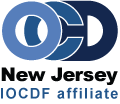Lisa Coyne, Ph.D. presented on “Fear and Flexibility: Integrating ACT with ERP to Shape Bravery-Based Behavior”
by Rachel Strohl, Psy.D.
On Sunday April 25, 2021, Lisa Coyne, Ph.D. presented at the 21th annual conference of OCD New Jersey (OCD NJ) and the 2nd virtual conference. Dr. Coyne is the Founder and Senior Clinical Consultant of the McLean OCD Institute for Children and Adolescents at McLean Hospital, and is an Assistant Professor at Harvard Medical School. She is the Founder and Executive Director of the New England Center for OCD and Anxiety (NECOA) and was elected President of the Association of Contextual Behavioral Science (ACBS). She is a member of the Clinical and Scientific Advisory Board and is on the Faculty of the Behavior Therapy Training Institute (BTTI) of the International OCD Foundation (IOCDF). She is also a licensed psychologist, a peer-reviewed ACT trainer, and author.
Dr. Coyne began by explaining the behavioral model of OCD with a specific understanding of obsessions and compulsions. She discussed the OCD spiral: intrusive thought > distress > ritual > relief > intrusive thought and so on, and explained that people do behaviors that “make sense in a particular context” to get short term relief. Avoidance behaviors include worry, reassuring self-talk, avoiding feared situations, etc. and result in “short term gain for long term pain.”
Exposure based treatment is based on learning theory: break pairing through repeated exposure and blocking avoidant behavior, which results in habituation. Exposure includes “approach” obsessions and resist engagement in avoidance behaviors. Dr. Coyne discussed the importance of the inhibitory learning model for exposure based treatment. Inhibitory learning: instead of “erasing” original learning, new learning inhibits the old learning. The goal of exposure is the “shaping approach” to behavior, which shapes flexible and effective behavior with OCD and anxiety cues. “Be scared, and do it anyway.”
Acceptance and commitment therapy (ACT) means accept, connect, and take action. Dr. Coyne used the quote, “life begins at the end of your comfort zone” to highlight ACT principles. ACT therapy has six processes: acceptance, defusion, contact with the present moment, self as context, values, and committed action. The processes help people build their lives so it feels more meaningful. The overview of DNA-V was explained as Discoverer, Noticer, Advisor, and Vitality/ Value within the context of social and self. DNA-V teaches variability in adaptive and flexible behavior.
Dr. Coyne discussed DNA-V deficits in OCD and what a therapist could look for to help with treatment. For example, is a person with OCD behaving with their values, is the Advisor of OCD in the role of ineffective threat-detecting, is the Noticer in touch with their 5-senses, and is the Discoverer using rigid and unhelpful behaviors?
The following was discussed when to use ACT with exposure based treatment: when clients are 1) unwilling to experience anxiety, 2) it’s “too hard,” 3) using ERP as a control strategy, 4) more obsessional OCD, and 5) rigid attachment to OCD “rules.” ACT enhances inhibitory learning in exposure by broadening flexibility, undermining control strategies to verbal rules, and supporting better tracking of experiences. The ACT approach to OCD shapes new behavior vs. targeting habituation with 1) curiosity, 2) willingness, 3) giving a s$#t, and 4) flexibility.
Dr. Coyne talked about the therapeutic alliance in ERP and creating the context by building a bond, creating task agreement, and become a “secure base.” Psychological flexibility was emphasized as helping inhibitory learning. Dr. Coyne used video case examples and metaphors throughout the presentation to highlight and illustrate the various topics, including untangling kids from rigid OCD rules. For instance, kids can find areas of “vitality” in their life (e.g., friends, sports, etc.) and compare “comfort behaviors” to resist vs. “discovery behaviors” to explore, and then create an “exposure menu.”
The “Living with OCD” Panel Review
By Megan Cox, Psy.D.
- A 31-year-old PhD student whose OCD diagnosis was missed in childhood when he was first told he had “school phobia.” While his symptoms did initially revolve around school, they later expanded to intrusive thoughts about a serious medical illness. He began relying on obsessive research to “logic his way” out of these thoughts, but found little relief. In his early 20’s, he began noticing that he couldn’t enjoy his social life and began engaging in destructive behaviors. While he initially had difficulty locating treatment that was a helpful fit, particularly in light of co-occurring diagnoses, he now has a care regime that includes therapy, medication, and medical marijuana, which he shared has been personally helpful for his symptom presentation.
- A 15-year-old whose OCD symptoms were first observed in elementary school when she began experiencing daily nausea, which she found frightening, and led to avoidance behaviors in the school setting. When she began working with a treatment provider in middle school, she reported that her functioning improved although her fears remained. As a high schooler, she has continued to make progress working with a specialist treating her OCD, dermatillomania, and emetophobia (fear of vomiting). She reported that therapy has assisted her in gaining insight and that she feels committed to spreading awareness about OCD and its impact.
- A 17-year-old who began experiencing intrusive thoughts related to religion and the devil at the age of 11. She began developing intense fears about becoming a Satanist and engaged in rituals to neutralize them. When she started treatment at the age of 16, she gave her OCD a name and drew what it looked like (“Vanessa”) and began exposure work. She started with writing a scary line down daily, and worked her way up to hanging a poster of the Devil on her wall. She reported feeling “desensitized” to thoughts about the Devil, and now understands that she is not “crazy” for having had these thoughts. Instead, she feels strong and powerful for addressing them and encourages others to “keep fighting!”
- A married father of one who began experiencing symptoms of OCD that filled his thoughts with relationship doubts. He shared that he developed an intense fear that he may not be attracted to his spouse, and the intensity and urgency with which he experienced this fear led him to do things like research ways for his spouse to “fix” the concern on which his OCD hyper-focused. He explained that he felt intense guilt and shame that he was becoming so “shallow,” although he knew rationally that these thoughts were not congruent with his values. He shared that even when he began working with an OCD specialist, he feared that his therapist may not understand the full picture and that the diagnosis may not be correct. However, a lightbulb moment occurred when his obsession “jumped” to a new intense fear, which he now understands to be a part of the “disease” of OCD. After engaging in exposure therapy, he feels he is reaching a place of acceptance about his difficult thoughts and feelings and how to respond to them. His story highlights the ways that OCD not only affects the individual, but also their loved ones, and he expressed gratitude for his supportive spouse.
- A 22-year-old teacher who shared about her lifelong history of OCD, beginning with bedtime rituals at the age of 4, contamination concerns, and a long list of fears about subjects that felt “taboo” to her during adolescence. As a part of exposure therapy, she developed the mantra, “Be a rebel,” and found relief from her symptoms. However, despite several years of relief from her symptoms, the end of college marked a period of stress about the “abyss of impending adulthood.” She chose to return for treatment with an ERP specialist to address feelings of hyper-responsibility, moral scrupulosity, and perfectionism. She reported that returning to therapy helped her better understand that OCD can affect any situation that involves uncertainty, and her brain is responding by “trying to protect itself” even when compulsions ultimately reveal themselves as counter-productive. She shared that “befriending” her OCD rather than struggling against it, and utilizing self-compassion, have been key parts of her treatment.
- A 37-year-old with a diagnosis of perinatal OCD. She reported that although she experienced OCD tendencies for most of her life, having her son 9 years ago triggered her symptoms to the extent that they were finally revealed. She shared about perinatal OCD, including how it is a common form of the disorder that is often missed compared with more widely discussed postpartum concerns like depression. Associated fears include the “worst case scenarios” for her son, concern that any “wrong thoughts or bad moves could cause imminent danger,” and that without the “just right” sensation, they are not safe to move forward. She has previously participated in intensive treatment including a residential program and a partial hospitalization program, and is currently benefiting from twice weekly therapy combined with medication. Although she shared that exposure therapy can feel “terrifying” at times, she has learned strategies to manage her fears. For example, she named her OCD “Ralph” and reminds herself during periods of high anxiety, “Here comes Ralph trying to creep in again. Ralph, you can be here, but I’m in charge. I’m the driver and you’re just a passenger.” She stated that she shared her story to encourage others to “never give up, and just keep going.”

